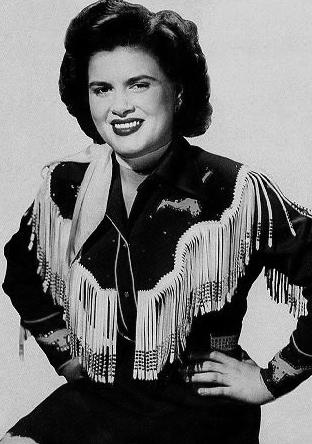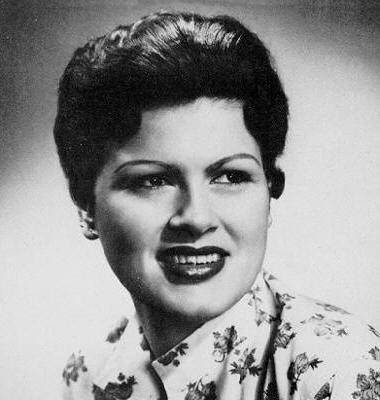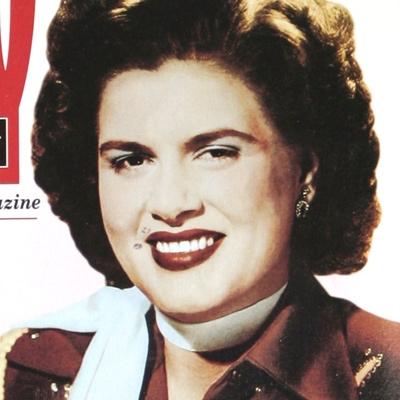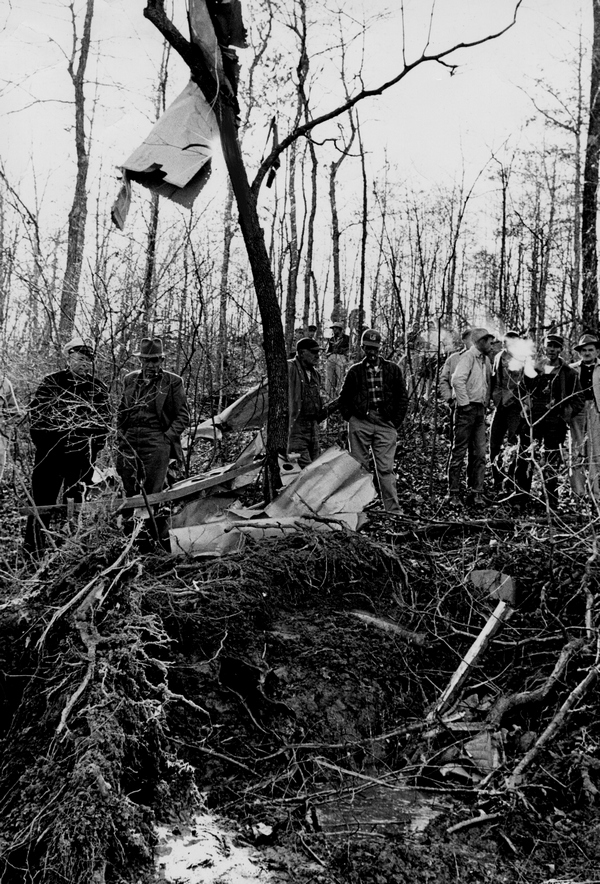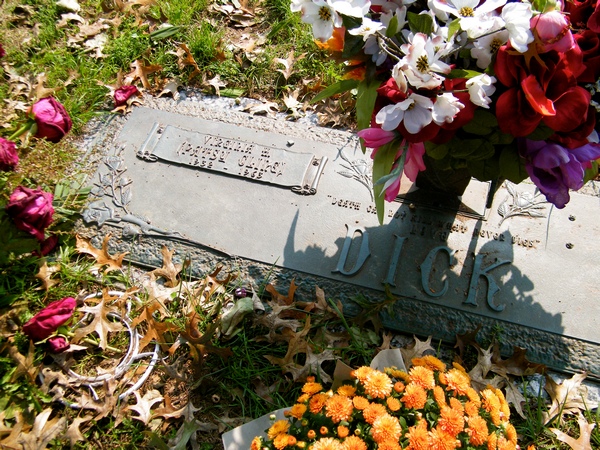Patsy Cline (Virginia Patterson Hensley)

Patsy Cline
Cline was born Virginia Patterson Hensley in 1932, in Winchester, Virginia, to Hilda Patterson Hensley, a 16-year-old seamstress, and Sam Hensley, a 43-year-old blacksmith. Patsy soon had a younger brother and sister, Samuel and Sylvia; the siblings were called Ginny, John, and Sis. The family moved often before settling in Winchester when Patsy was 8. She grew up “on the wrong side of the tracks”. Sam deserted his family in 1947, but the Hensley home was reportedly quite happy. Cline was introduced to music at an early age, singing in church with her mother. She admired stars such as Kay Starr, Jo Stafford, Hank Williams, Judy Garland, and Shirley Temple. She had perfect pitch. She was self-taught and could not read music. When she was thirteen, she was hospitalized with a throat infection and rheumatic fever. “The fever affected my throat and when I recovered I had this booming voice like Kate Smith”.
To help support her family after her father abandoned them, she dropped out of high school and worked various jobs, often performing as a soda jerk and waitress by day at the Triangle Diner, across the street from her school, John Handley High. After several weeks of watching performers through the window at her local radio station, she asked WINC disc jockey and talent coordinator Jimmy McCoy if she could sing on his show. Her first performance on radio in 1947 was so well received that she was asked back. This led to performances at local nightclubs, wearing fringed Western stage outfits that her mother made from Patsy’s designs. Cline performed in variety and talent showcases in and around the Winchester and Tri-State areas. Coupled with increasing appearances on local radio, she attracted a large following. In 1954 Jimmy Dean, a young country star in his own right, learned of her and she became a regular with Dean on Connie B. Gay’s Town and Country Jamboree radio show, airing weekday afternoons live on WARL in Arlington, Virginia.
She married contractor Gerald Cline on September 19, 1953 and divorced him on July 4, 1957. The dissolution of that marriage was blamed on their considerable age difference and on the conflict between her desire to sing professionally and his desire that she adopt the conventional role of a housewife. This marriage produced no children. She married linotype operator Charlie Dick on September 15, 1957. Their marriage produced two children: Julie Dick (August 25, 1958) and Randy Dick (February 28, 1961).
Bill Peer, her second manager, gave her the name Patsy, from her middle name and her mother’s maiden name, Patterson. In 1955 he got her a contract at Four Star Records, the label with which he was then affiliated. Four Star was under contract to the Coral subsidiary of Decca Records. Patsy signed with Decca at her first opportunity three years later. Her first contract allowed her to record compositions only by Four Star writers, which Cline found limiting. Later, she expressed regret over signing with the label, but thinking that nobody else would have her, she took the deal. Her first record for Four Star was “A Church, A Courtroom & Then Good-Bye”, which attracted little attention, although it led to appearances on the Grand Ole Opry. As these performances were not “records” per se, they were not governed by her contract, and she could sing what she wanted, within reason. This somewhat eased her “stifled” feeling. Between 1955 and 1957, Cline recorded honky tonk material, with songs like “Fingerprints”, “Pick Me Up On Your Way Down”, “Don’t Ever Leave Me Again”, and “A Stranger In My Arms”. Cline cowrote the latter two. None of these songs gained notable success. She experimented with rockabilly. According to Decca Records producer Owen Bradley, the Four Star compositions only hinted at Patsy’s potential. Bradley thought that her voice was best-suited for pop music, but Cline sided with Peer and the other Four Star producers, insisting that she could only record country songs, as her contract also stated. Every time Bradley tried to get her to sing the torch songs that would become her signature, she would panic, missing her familiar banjo and steel guitar. She recorded 51 songs with Four Star.
On July 1, 1955 Cline made her network television debut on the short-lived television version of the Grand Ole Opry on ABC-TV. This was followed by an appearance on the network’s Ozark Jubilee later that month,[10]:p.80 before returning to the show in April.[clarification needed]
Later that year, while looking for material for her first album, Patsy Cline, “Walkin’ After Midnight” appeared, written by Donn Hecht and Alan Block. Cline initially did not like the song because it was, according to her, “just a little old pop song.” However, the song’s writers and record label insisted that she record it.
In the late fall of 1956, she auditioned for Arthur Godfrey’s Talent Scouts in New York City, and was accepted to sing on the CBS-TV show on January 21, 1957. Godfrey’s “discovery” of Cline was typical. Her scout, actually her mother, presented Patsy who initially was supposed to sing “A Poor Man’s Roses (Or a Rich Man’s Gold)”, but the show’s producers insisted she sing “Walkin’ After Midnight” instead. Though heralded as a country song, recorded in Nashville, Godfrey’s staff insisted that Cline appear in a cocktail dress rather than in one of her mother’s hand-crafted cowgirl outfits.
The audience’s enthusiastic ovations pushed the applause meter to its apex, winning the competition for her. After the Godfrey show, listeners began calling their local radio stations to request the song, so she released it as a single. Although Cline had been performing for almost a decade and had appeared on national TV three times, it took Godfrey to make her a star. For a couple of months thereafter, Cline appeared regularly on Godfrey’s radio program. Disagreements over creative control caused her to move on. “Walkin’ After Midnight” reached No. 2 on the country chart and No. 16 on the pop chart, making Cline one of the first country singers to have a crossover pop hit. The single drove her success for the next year or so. She stayed visible by making personal appearances and performing regularly on Godfrey’s show, as well as performing for several years on Ozark Jubilee (later Jubilee USA). She had no other hits with Four Star. Cline composed and recorded “A Stranger in My Arms” and “Don’t Ever Leave Me Again” in 1957 under her birth name, Virginia Hensley. A month after her recording session, she met Charlie Dick, a good-looking ladies man who frequented the local club circuit Cline played on weekends. His charisma and admiration of Cline’s talents captured her attention, and their relationship resulted in a marriage that lasted until her death. Though their love affair was publicized as controversial, Cline regarded Dick as “the love of her life”. After the birth of their daughter, Julie, in 1958, they moved to Nashville, Tennessee.
In 1959 Cline met Randy Hughes, a session guitarist and promotion man. Hughes became her manager and helped her change labels. When her Four Star contract expired in 1960, she signed with Decca Records-Nashville, directly under the direction of legendary female-singer country music producer Owen Bradley. He was responsible for much of Cline’s success and positively influenced the careers of both Brenda Lee and Loretta Lynn. Even though she was still scared of the lush Nashville Sound arrangements, Bradley considered Cline’s voice best-suited for country pop-crossover songs. Bradley’s direction and arrangements helped smooth her voice into the silky, torch song style for which she won fame. Cline’s first release for Decca was the country pop ballad “I Fall to Pieces” (1961), written by Hank Cochran and Harlan Howard. The song was promoted and won success on both country and pop music stations. On the country charts, the song slowly climbed to the top, garnering her first Number One ranking. In a major feat for country singers at the time, the song hit No. 12 on the pop and No. 6 on the adult contemporary charts, making her a household name and demonstrating that women could achieve as much crossover success as men.
In 1960, Cline realized a lifelong dream when the Grand Ole Opry accepted her request to join the cast, making her the only person to achieve membership in such a fashion. She became one of the Opry’s biggest stars. Even before that time, believing that there was “room enough for everybody”, and confident of her abilities and appeal, Cline befriended and encouraged women starting out in the country music field at that time, including Loretta Lynn, Dottie West, Jan Howard, sixteen-year-old Brenda Lee and a thirteen-year-old steel-guitar player named Barbara Mandrell with whom Cline once toured, all of whom cited her as a major influence. According to both Lynn and West, Cline always gave of herself to friends, buying them groceries and furniture and even hiring them as wardrobe assistants. On occasion, she paid their rent, enabling them to stay in Nashville and continue pursuing their dreams. Honky-tonk pianist and Opry star Del Wood said, “Even when she didn’t have it, she’d spend it—and not always on herself. She’d give anyone the skirt off her backside if they needed it.”
She cultivated a brash and gruff exterior that allowed her to be considered “one of the boys”. This allowed her to befriend male artists as well, including Roger Miller, Hank Cochran, Faron Young, Ferlin Husky, Harlan Howard and Carl Perkins, with all of whom she socialized at famed Nashville establishment Tootsie’s Orchid Lounge, next door to the Opry. In the 1986 documentary The Real Patsy Cline, singer George Riddle said of her, “It wasn’t unusual for her to sit down and have a beer and tell a joke, and she’d never be offended at the guys’ jokes either, because most of the time she’d tell a joke dirtier than you! Patsy was full of life, as I remember.” Cline used the term of endearment “Hoss” to refer to her friends, both male as well as female, and referred to herself as “The Cline”. Patsy met Elvis Presley in 1962 at a fundraiser for St. Jude Children’s Research Hospital and they exchanged phone numbers. Having seen him perform during a rare Grand Ole Opry appearance, she admired his music, called him The Big Hoss, and often recorded with his backup group, The Jordanaires. By this time, Cline controlled her own career, making it clear to all involved that she could stand up to any man, verbally and professionally, and was ready to challenge their rules if they interfered with her. At a time when concert promoters often cheated stars by promising to pay them after the show but skipping out with the money before the concert ended, Cline demanded her money before she took the stage by proclaiming: “No dough, no show”, a practice that became the rule. According to friend Roy Drusky in the The Real Patsy Cline: “Before one concert, we hadn’t been paid. And we were talking about who was going to tell the audience that we couldn’t perform without pay. Patsy said, ‘I’ll tell ’em!’ And she did!” Friend Dottie West stated in amazement some 25 years later in an interview that “It was common knowledge around town that you didn’t mess with ‘The Cline!'”
Cline bore a son, Randy in 1961. On June 14, she and her brother Sam were involved in a head-on collision on Old Hickory Boulevard in Nashville. The impact threw Cline into the windshield, nearly killing her. Upon arriving at the scene, Dottie West picked glass from Cline’s hair, and went with her in the ambulance. When help arrived, Cline insisted that the other car’s driver be treated first. (West witnessed this, and the impression left upon her may have contributed to an unfortunate decision she made some three decades later. In 1991, West was seriously injured in a car accident, and like Cline, she too insisted that her driver be treated first. West died from her injuries, possibly because she had declined to be treated immediately.) Cline later stated that she saw the female driver of the other car die before her eyes. Cline spent a month in the hospital, suffering from a jagged cut across her forehead that required stitches, a broken wrist and a dislocated hip. Both Nassour and friend Billy Walker (who died in a vehicle accident in 2006) reported that Cline rededicated her life to Christianity while in the hospital, where she received thousands of cards and flowers from fans. When she left the hospital, her forehead was visibly scarred. For the remainder of her career, she wore wigs and makeup to hide the scars, along with headbands to relieve the forehead pressure that caused headaches if left unattended. Six weeks later, she returned to the road on crutches with a new appreciation for life. A series of recordings titled Patsy Cline: Live at the Cimarron Ballroom from her first concert after the crash were released in 1997 and feature dialogue of Cline interacting with the audience, reviewing her live performances. Recorded in Tulsa, Oklahoma as a sound check, these archives were found in the attic by a later owner of one of Cline’s residences and were given to the family.
Friends Dottie West, June Carter Cash, and Loretta Lynn recalled Cline telling them during 1962–1963 that she felt a sense of impending doom and did not expect to live much longer.[20] Cline, known for her generosity, had begun giving away personal items to friends, writing her will on Delta Air Lines stationery and asking close friends to care for her children should anything happen to her. She told The Jordanaires’ bass singer Ray Walker as she exited the Grand Ole Opry the week before her death: “Honey, I’ve had two bad ones (accidents). The third one will either be a charm or it’ll kill me.” On March 3, 1963, Cline performed at a benefit at the Soldiers and Sailors Memorial Hall, Kansas City, Kansas for the family of disc jockey “Cactus” Jack Call. He had died in an automobile crash a little over a month earlier. Call was a longtime DJ for KCKN, but had switched to KCMK a week before his death in January 25, 1963 at the age of 39.[21] Also performing on the show were George Jones, George Riddle and The Jones Boys, Billy Walker, Dottie West, Wilma Lee and Stoney Cooper, George McCormick, the Clinch Mountain Boys as well as Cowboy Copas and Hawkshaw Hawkins.
Reports vary as to whether Cline, ill with the flu, gave two or three performances. Some sources say the shows were at 2 p.m. and 5:15 p.m., but other sources say an 8 p.m. show was added due to popular demand. The shows were standing-room only. For the 2 p.m. show, she wore a sky-blue tulle-laden dress, for the 5:15 show a red shocker, and for the closing show at 8 p.m., Cline wore white chiffon and closed the show to a thunderous ovation. Her final song was the last she had recorded the previous month, “I’ll Sail My Ship Alone”. Cline, who had spent the night at the Town House Motor Hotel, was unable to fly out the day after the concert because Fairfax Airport was fogged in. West asked Patsy to ride in the car with her and husband, Bill, back to Nashville (approximately a 16 hour drive), but Cline refused, saying, “Don’t worry about me, Hoss. When it’s my time to go, it’s my time.” On March 5, she called her mother from the motel and checked out at 12:30 p.m. to go the short distance to the airport to board the Piper PA-24 Comanche plane, aircraft registration number N-7000P. The plane stopped once in Missouri to refuel and subsequently landed at Dyersburg Municipal Airport in Dyersburg, Tennessee at 5 p.m.
Hughes was the pilot, but was not trained in instrument flying. Hawkins had accepted Billy Walker’s offer after Walker left on a commercial flight to take care of a stricken family member. The Dyersburg, Tennessee airfield manager suggested that they stay the night after advising of high winds and inclement weather, and even offered them free rooms and meals, but Hughes responded, “I’ve already come this far. We’ll be there before you know it.” The plane took off at 6:07 p.m. (Hughes’ flight instructor had also trained Jim Reeves, whose plane crashed the following year. Neither pilot was instrument-rated and both attempted using visual flight rules known as VFR—impossible in the driving rain faced by both flights.) Cline’s flight encountered inclement weather and crashed on the evening of March 5, 1963. Her recovered wristwatch had stopped at approximately 6:20 p.m. The plane wreckage was located approximately 90 miles (140 km) from its Nashville destination in a forest outside Camden, Tennessee. Forensic examinations concluded that everyone aboard had been killed instantly from their injuries and did not suffer. Until the wreckage was discovered the following dawn and reported on the radio, friends and family had not given up hope. Endless repetitions of calls such as “Did you hear anything?” “No, did you?” tied up the local telephone exchanges to such a degree that other emergencies occurring over the same period had trouble getting through. The lights at the destination Cornelia Fort Airpark were kept on throughout the night as reports of the missing plane were broadcast on radio and TV.
Born
- September, 08, 1932
- Winchester, Virginia
Died
- March, 05, 1963
- Camden, Tennessee
Cemetery
- Memorial Site
- Camden, Tennessee


